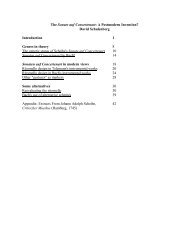SEVEN PAPERS ON EXISTENTIAL ANALYSIS ... - Wagner College
SEVEN PAPERS ON EXISTENTIAL ANALYSIS ... - Wagner College
SEVEN PAPERS ON EXISTENTIAL ANALYSIS ... - Wagner College
Create successful ePaper yourself
Turn your PDF publications into a flip-book with our unique Google optimized e-Paper software.
the first time. Evidently, this was the “something important” that had happened, the meaning of<br />
which had been unfolding ever since. There was no need for me to comment.<br />
As for other details, a year or so ago Will told me that he was found by a girlfriend and<br />
had begun to dance—literally—for the first time in his life. Having been a spectator at social<br />
gatherings, he had began to play with others in this way, dancing with them. He was no longer<br />
interested in playing for others as a musician. I surmised that the play element of sex has also<br />
become lively in his life, but there was reason to ask him about that.<br />
6. In conclusion. I want to quote an observation by Heidegger in Being and Time that I<br />
realize has played a large part in the development of my ideas about eros: “Höher als die<br />
Wirklichkeit steht die Möglichkeit” (Heidegger, 1973, p. 63): “Higher than actuality stand<br />
possibility” (Heidegger’s emphasis). I should append the sentence that follows and concludes<br />
the powerful second “Introduction” to Heidegger’s work, since it is meaningful to those of us who<br />
work phenomenologically in the human sciences. There he wrote: “Das Verständnis der<br />
Phänmenologie liegt einzig im Ergreifen ihrer als Möglichkeit” (Heidegger, 1973, p. 489):<br />
“Understanding phenomenology is possible only by seizing on it as a possibility.” In the footnote<br />
to this sentence, by the way, Heidegger pays tribute to Husserl and their common undertaking,<br />
“disclosing (Erschliessung) ‘the things themselves’.”<br />
I, for my part, pay tribute to Will, who led me to see eros at play in existential analysis and,<br />
in fact, everywhere in the world between human beings, for example as the source of deep<br />
friendships, relationships that have very little currency in the postmodern world. Like anyone who<br />
comes to meet with a psychotherapist, what was missing in “Billy’s” life was an occasion to<br />
experience the genuine, passionate longing for and fascination with the prime indiscernible—<br />
sheer possibility. As it happens and as will always be the case in existential analysis, which is a<br />
venture of mutuality, he brought it—the prime indiscernible—to my life, too.<br />
References<br />
Bowlby, J. (1983) Attachment and loss (volume 1). New York: Basic Books.<br />
Buber, M. (1970). I and thou. New York: Scribners.<br />
Cantarella, E. (1988). Seconda Natura. Rome: Riuniti. Translated as Bisexuality in the ancient<br />
world (1992). New Haven: Yale University Press.<br />
Erikson, E. (1977). Toys and reasons: Stages in the ritualization of experience. New York: W.W.<br />
Norton.<br />
Foucault, M. (1977, 1984), The history of sexuality. 3 volumes. New York: Vintage.<br />
Fromm, E. (1994). Escape from freedom. New York: Henry Holt.<br />
Groos, K. (2005). The play of animals. Whitefish: Kessinger.<br />
Groos, K. (2007). The play of man. Whitefish: Kessinger.<br />
Halperin, D. (1990). Before sexuality. Princeton: Princeton University Press.<br />
Heidegger, M. (1973). Being and time. Oxford: Blackwell.















